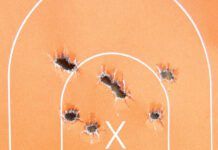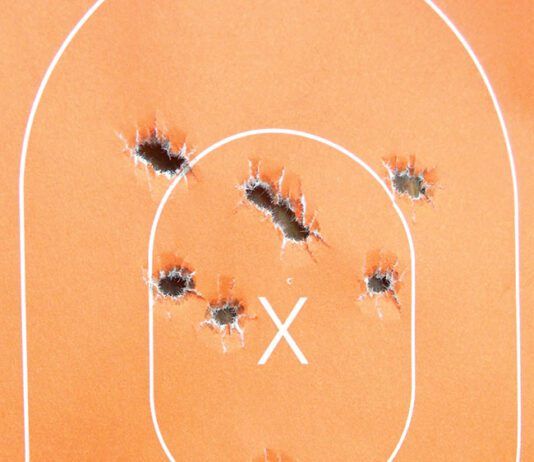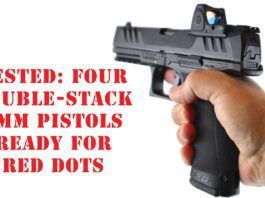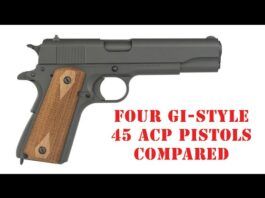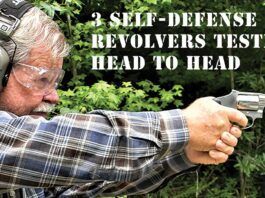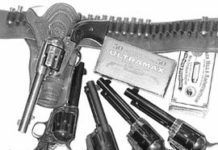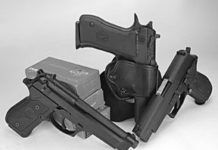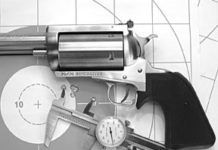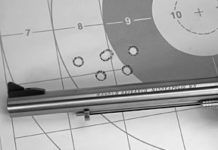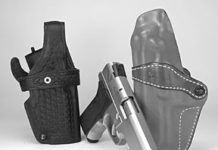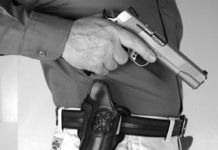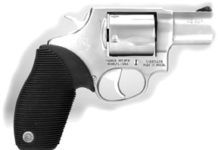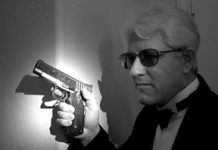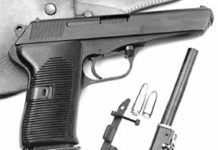3-inch .357 Magnum Revolvers: Buy Ladysmith, Rugers Wheelgun
The Smith & Wesson gun, $584, and Sturm, Ruger's KGPF-331, $529, will do great work as self-defense arms. But we would choose one over the other.
Subcompact 9mm Pistols: Our Pick for Concealed Carry and Combat
We determine the strengths and weaknesses of Kahr's $600 P9, Springfield's latest XD, $490, and the $640 Glock Model 26.
.45 Single-Action Colts and Clones: USFAs Rodeo Is Our Pick
One hundred and thirty years ago Colt's brought out its Model P, also known as the Single Action Army revolver. (For those who wonder, Sam Colt never saw the Model P. He died in 1862.) The company is still making the old thumb-buster, and a host of companies are producing clones of it in what seems to be ever-increasing numbers. The game of Cowboy Action Shooting must surely be one of the main driving forces behind the continued onslaught of fine and finer single actions, but the fact remains that these revolvers are viable sporting, hunting, and even self-defense firearms, and serve their owners in as many capacities as they did in the 1870s.
9mm Pistols: We Compare Beretta, SIGArms, and Magnum Research
The 9mm continues to be one of the country's favorite guns, if recent manufacturing data are to be believed. According to the BATF's Annual Firearms Manufacturing and Export Report for 2001, 626,836 pistols were produced (the latest year for which figures are available). Of that sum, 213,378 were in calibers above .380 to 9mm. That's almost 30,000 more for the next-largest caliber segment, guns above 9mm to .50 caliber.
More Booming Revolvers: This Time, a .30-30 BFR Struts Its Stuff
We hate to admit it, but we've been had. All this time we thought that the revolvers from Magnum Research in the May issue were in fact the true BFRs — Biggest Finest Revolvers. These guns weighed in at 76 ounces and measured nearly 16 inches in length. But along comes two BFRs that are more than 2 inches longer and weigh almost a full pound more. Now we suppose that when it comes to the .45-70 and .450 Marlin guns reviewed last month, the "B" in BFR merely stands for bigger, not biggest.
But this month we step up to two rifle cartridges chambered in our test guns, the .30-30 Winchester and .444 Marlin. Besides being a well-known rifle cartridge, .30-30 ammunition is cheap and plentiful. If we numb our hands and wrists while shooting, at least we won't stun our wallets. In the .444 Marlin revolver, we wondered how gun, and shooter, would stand up to this big, straight-walled cartridge.
We got our guns from the Magnum Research Custom Shop, so there were variations in what we tested and what's available in factory production. The .444 Marlin BFR offered by Magnum research has a round, non-fluted cylinder. Our test .444 had fluting, but was otherwise a production model. The .30-30 Win. BFR (available from Magnum Research Custom Shop, Contract Mfg. Inc., 1594 College Rd., Baxter, MN 56425, telephone [218] 824-0080) is a custom chambering which costs $1,400. The Custom Shop has developed a number of custom calibers that are not available in production revolvers, such as the .218 Bee, .45/90 Win., .38-55 Win., and .375 Win. They are all $1,400. The guns are built to order with special caliber engraving on the frame. "Magnum's Custom Shop is newly created and seeks to fill a niche for shooters who want something other than the standard BFRs," said Jim Tertin of Contract Mfg. Inc.
Magnum Research BFR Revolvers
The market for big revolvers is actually rather small. The biggest-selling revolvers are smaller models that offer concealment or portability as well as simplicity. For hunting, a revolver or any other handgun should be of the largest caliber one can shoot for the sake of a quick kill. Then again, some very big revolvers are for the hunted. Super calibers like the .454 Casull and .480 Ruger can function as a more portable alternative to a rifle or shotgun in places like Alaska, where being surprised by a bear in your driveway isn't out of the question. Revolvers that shoot a rifle caliber are another way to go because rifle ammunition may indeed be cheaper and more plentiful than a specialty round like the .454 Casull or 480 Ruger. When Magnum Research expanded its line of BFR (biggest, finest revolvers) products to include models that chamber the .45-70 Government and .450 Marlin we decided to test them. First, we wanted to know if the guns themselves could stand up to these cartridges. We also wanted to see how much accuracy could be achieved when these rounds were placed in a revolver instead of a rifle. Here's what we found.
Police Trade-In Pistols: Bargains, Busts or Buyers Beware?
One of the alternatives to the high cost of a new pistol is to buy used. In lieu of finding a creampuff that was only fired by a little old lady on Sundays, one source of used pistols is the police trade-in market. Through firms like Interstate Arms (978-667-7060), pistols formerly owned by active law-enforcement personnel are available to dealers at a wholesale price. The catch for the typical consumer is that a dealer, i.e. an FFL holder, must arrange for transfer. This also means that retail price can vary according to fees, typically 10 to 15 percent of the gun's cost with a $25 minimum. The prices we list are a dealer's cash price, or the prices we paid to get the guns without FFL fees.
Keep in mind, however, that not every dealer is willing to go through the hassle of ordering a gun of unpredictable condition which may result in you rejecting it, which can cost return shipping charges and possibly a re-stocking fee. Be that as it may, we decided to order four .40 S&W pistols that have been commonly found in uniformed service. They were the Ruger KP94DAO, the Glock Model 22, Smith & Wesson's Model 4046, and the SIGArms P229.
We felt buying these guns was a calculated risk. We were able to ascertain their age by checking the serial numbers with the manufacturers. New, each pistol was good enough to be chosen for police departments nationwide. But why were they traded in? Did the design of these pistols become outdated or were they beginning to show their age with more evidence than mere holster wear? Let's look under the hood and take them for a ride.
Philippine 1911s: Do Foreign .45s Compare To A Big-Name Pistol?
Today, the consumer has more sidearms to choose from than ever before. Manufacturers have greater technical, metallurgical, and mechanical capabilities than ever before. A wider variety of effective firing systems have been developed over the last half century alone than perhaps in all the years prior. (Not to mention alternative materials such as polymer and titanium.) But which firearm do the majority of competitors prefer, and which system is making a comeback in the elite forces of the military? The Browning-based 1911 pistol. Perhaps this is why Smith & Wesson has decided to enter the 1911 sweepstakes with a just-introduced gun, the SW1911 No. 108282, a 5-inch 8+1 stainless single action that lists for $895.
Another reason must be the desire to recapture markets that S&W previously dominated with wheelguns, such as law enforcement. When the world of blue went to the semi-automatic pistol, the company's pistols were competitive, but they've recently disappeared from the holsters of many departments. The SW1911 will obviously seek to reverse that trend.
But there are plenty of other 1911 makers looking for a spot in the market. For example, we've been charting the progress of various firearms from Philippines-based Armscor. Though we have recommended some Armscor products, such as some self-defense shotguns in the May 2002 issue, the company's 1911-style pistols have not been completely satisfactory, in our view.
Pocket Pistol Pair-Off: We Test A Set of .380 Surplus Handguns
The .380 cartridge has been around since early in the last century. It was another of John Browning's designs, and has been known as the 9mm Kurz, 9x17, 9mm Browning Short, and .380 ACP. We also know it as the .380 Automatic, or simply the .380 Auto. It's been chambered in a host of small autoloading pistols, some of them quite famous, such as Walther's PPK.
The .380 is not a cartridge many of us would pick for all-around use. It's hardly a plinking cartridge, because of the relatively high cost of ammunition, and because the pistols that chamber it are generally not all that accurate. Reloaders don't exactly flock to the diminutive cartridge, for a variety of reasons. Ammunition manufacturers have produced some excellent fodder in recent years for the tiny guns, but none of it can make a mountain-size "stopper" out of the molehill .380 Auto.
Guns for the cartridge abound, some of them expensive, some of them — like the ones tested here — discontinued for a variety of reasons. Some .380s are great firearms, and some would make better table lamps. We acquired four examples of discontinued .380-Auto handguns, all of which pop up on the used market from time to time. They were all locked-breech pistols, with barrel locks similar to that of a full-size 1911 .45 Auto. Our test guns included the Colt Mustang and its lighter twin the Mustang Pocketlite, both of which cost in the $500 range; an Iver Johnson Pony ($250) that was similar in size and overall shape to the Colts, and a close clone of the Pony from Firearms International ($300). Here are our findings.
Big-Bore Snubbies: Taurus and Smith & Wesson Compete
We pit Taurus's small but weighty .45 ACP against S&W's bigger but lighter .44 Special and find two carryable revolvers with plenty of stopping power but surprisingly mild manners.
Commander-Sized Poly 1911 .45s: Kimber, Wilson, and STI Face Off
If you find the range in prices for the very similar guns described in the deck above to be shockingly wide, then you had the same reaction as our staff. After all, each gun has a polymer body. You know, plastic, the material that was supposed to reduce cost. But atop each plastic grip frame is the 1911 action, and as we have said before, this is a design that requires some real hands-on work to make it accurate and smooth. Even if you replace most of the work with a machine, there is still hand fitting, and those darned CNC mills are pretty expensive as well.
At $875, the Kimber Pro Ten II was the lowest priced of our three test guns. STI, which originally stood for Strayer-Tripp International, offers designs so advanced it refers to its line of Browning inspired pistols as 2011s. The VIP model is twice the price of the Kimber at $1,725. In the middle at $1125 is the KZ45 Compact from Wilson Combat, the first series of plastic guns to come out of the Berryville, Arkansas, shop and also their least expensive model.
Given the price range of these guns and the reputation of their manufacturers, we figured it would be a surprise if any of them malfunctioned. What we were looking for was any substantial difference in performance among the three. Also, we wanted to know if polymer played a key role in the success or failure of these pistols.
CZ-52 9mm Barrel Is A Winner; So Is Savages Long-Range Rifle
For less than $100, you can change out barrels in the .30 Tokarev pistol and shoot cheaper 9mm ammo. Also, Savage's Model 12VSS sets a new standard for .308 rifles.


